THE TIPLINE IS STANDING BY Indoor petting zoo opening up in one of those abandoned Sears stores? To cover this city well, Swamplot needs your tips. So if you see something interesting going on in your neighborhood, let us know! Taken some nice pics from around town? Send them to our Flickr group. If you’ve uploaded a video to YouTube you think we might be interested in, send us a link. While you’re at it, be sure to like us on Facebook, follow us on Twitter, and sign up to be on Swamplot’s email list.
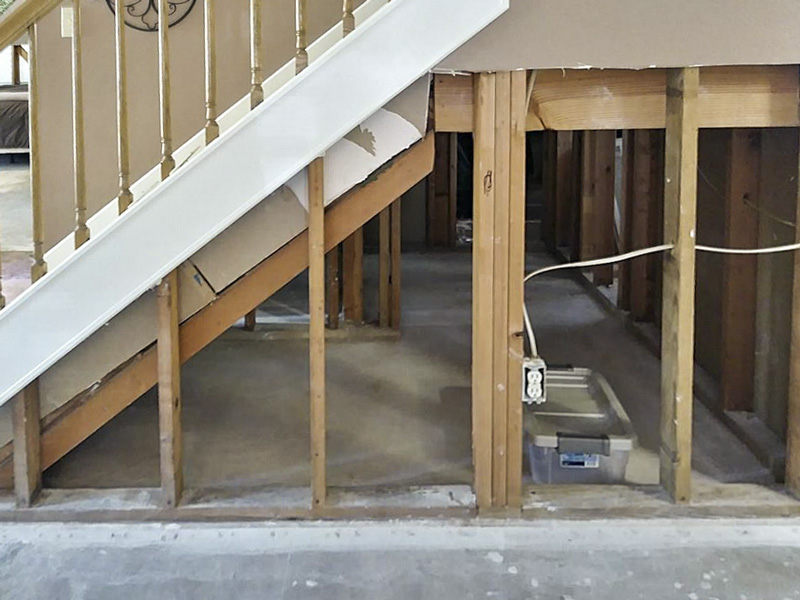
- 702 Olde Oaks Dr. [HAR]
COMMENT OF THE DAY: THE MORE WEST HOUSTON FLOODS, THE MORE IT STAYS THE SAME 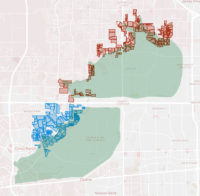 “Why does it matter? Even after the flood, I am okay with them building there on private land. Flood risk is just one of a million things that you should look at when buying a home. Heck, even knowing what we know now, I might still buy there in the right situation. If I was looking to buy a home in that general area, and the only way I can get one is to build one on the far back end of the reservoir, I would still do it today. Even after we calibrate the models to include the recent rainfall events, we will still find that this is an outlier.” [Rex, commenting on How It Came To Pass That Hundreds of Families Purchased Homes Inside Houston’s Reservoirs; previously on Swamplot] Map of subdivisions in or along the edge of the Addicks and Barker reservoirs: ProPublica
“Why does it matter? Even after the flood, I am okay with them building there on private land. Flood risk is just one of a million things that you should look at when buying a home. Heck, even knowing what we know now, I might still buy there in the right situation. If I was looking to buy a home in that general area, and the only way I can get one is to build one on the far back end of the reservoir, I would still do it today. Even after we calibrate the models to include the recent rainfall events, we will still find that this is an outlier.” [Rex, commenting on How It Came To Pass That Hundreds of Families Purchased Homes Inside Houston’s Reservoirs; previously on Swamplot] Map of subdivisions in or along the edge of the Addicks and Barker reservoirs: ProPublica
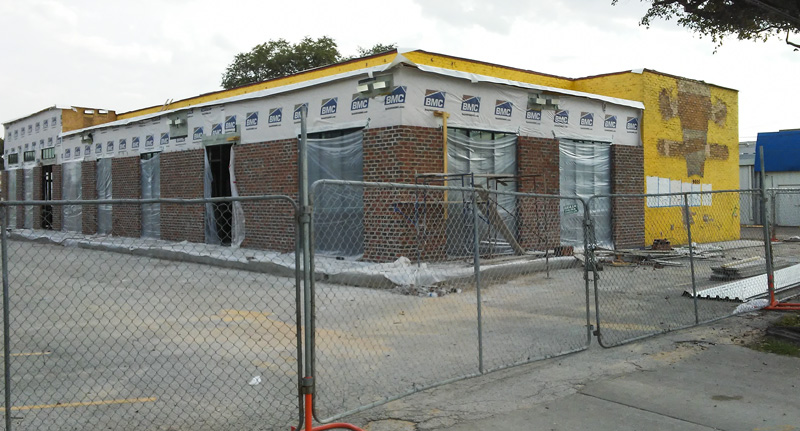
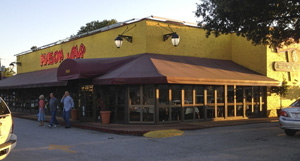 The neon signage facing the I-10 feeder road at the former home of the Mason Jar has been stripped off, as the spot gets built out for a takeover by the Goode folks (as seen in this shot captured by a reader this week). After the ongoing expansion and patio-making wraps up, the spot will offer a menu at least somewhat reminiscent of the company’s Kirby Dr. taqueria, based on barbecue heir and current owner Levi Goode’s musings to Eric Sandler last month. The new brand’ll be called the Goode Company Kitchen & Cantina; Goode told Sandler there’s a second one planned for the Woodlands.
The neon signage facing the I-10 feeder road at the former home of the Mason Jar has been stripped off, as the spot gets built out for a takeover by the Goode folks (as seen in this shot captured by a reader this week). After the ongoing expansion and patio-making wraps up, the spot will offer a menu at least somewhat reminiscent of the company’s Kirby Dr. taqueria, based on barbecue heir and current owner Levi Goode’s musings to Eric Sandler last month. The new brand’ll be called the Goode Company Kitchen & Cantina; Goode told Sandler there’s a second one planned for the Woodlands.
A few old Mason Jar labels are still visible to the east of the building:
IN WHICH THE OWNER OF THAT MANNEQUIN-PACKED HOUSE IN RICHMOND ANSWERS YOUR QUESTIONS AND THE REST OF THE COUNTRY’S  “I’m just trying to sell my house,” says the long-time artist resident of 4302 Colony West Dr. in Richmond (the mind-boggling contents of which sent no fewer than 10 readers scrambling to send the listing to the Swamplot tip line earlier this week).  “No, I’m not a hoarder. I could go down the list of things people are accusing me of. Yes, I own a weird business, but artists are weird, and if you find a normal artist [they’re] probably not a good one.” Those answers are all prompted by questions from Marcelino Benito, who toured the house this week for KHOU after the listing went nationally viral. The house and its contents have been viewed millions of times and have made the news in such far flung locations as St. Louis, MO, (where local station KMOV referred to its interior decor as ‘the stuff of nightmares‘) — in addition to being gawked at by readers of both the Huffington and the New York posts. As for what seems to be another burning question on the minds of some of the folks calling in with actual offers on the home — “Will you leave a mannequin for me?” — the owner’s answer appears to be a furrowed eyebrow or 2 and a “well . . . okay.” [KHOU; previously on Swamplot] Photo of 4302 Colony West Dr.: HAR
“I’m just trying to sell my house,” says the long-time artist resident of 4302 Colony West Dr. in Richmond (the mind-boggling contents of which sent no fewer than 10 readers scrambling to send the listing to the Swamplot tip line earlier this week).  “No, I’m not a hoarder. I could go down the list of things people are accusing me of. Yes, I own a weird business, but artists are weird, and if you find a normal artist [they’re] probably not a good one.” Those answers are all prompted by questions from Marcelino Benito, who toured the house this week for KHOU after the listing went nationally viral. The house and its contents have been viewed millions of times and have made the news in such far flung locations as St. Louis, MO, (where local station KMOV referred to its interior decor as ‘the stuff of nightmares‘) — in addition to being gawked at by readers of both the Huffington and the New York posts. As for what seems to be another burning question on the minds of some of the folks calling in with actual offers on the home — “Will you leave a mannequin for me?” — the owner’s answer appears to be a furrowed eyebrow or 2 and a “well . . . okay.” [KHOU; previously on Swamplot] Photo of 4302 Colony West Dr.: HAR

- 10611 Gawain Ln. [HAR]
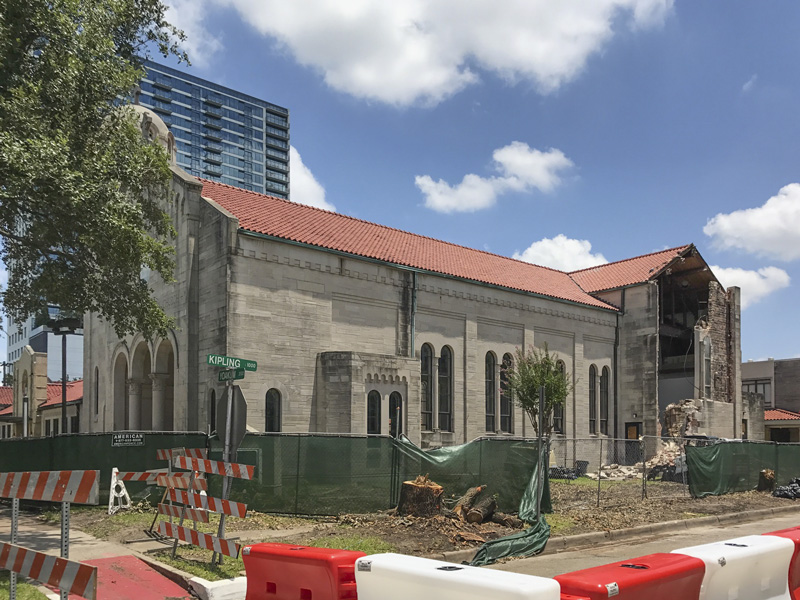
 A Sunday field trip earned a reader a peek into the main sanctuary of the Annunciation Orthodox Cathedral, now being cracked open so a dome can be placed on top (along with more seating down below). The renderings of the planned changes, shown here facing the corner of Kipling St. and Yoakum Blvd., have been updated since they were submitted last year for that variance request application:
A Sunday field trip earned a reader a peek into the main sanctuary of the Annunciation Orthodox Cathedral, now being cracked open so a dome can be placed on top (along with more seating down below). The renderings of the planned changes, shown here facing the corner of Kipling St. and Yoakum Blvd., have been updated since they were submitted last year for that variance request application:
COMMENT OF THE DAY: HOW TO HELP CANINO’S NET THAT DESTINATION FISH MARKET APPEAL 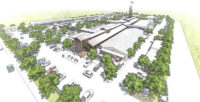 “Something that seems to make other markets around the world such successful destinations (Pike Place, Borough Market, Reading Terminal, etc.) is their accessibility within a dense urban core. In each case, the locations are accessible to pedestrians and located near high-traffic public transit locations. They are also near other walkable destinations like stores and restaurants, art galleries and museums; within walking distance from hotels and other destinations. It will be interesting to see how this works out in Houston on Airline Dr., with all of the car traffic and expansive space needed to accommodate parking. I hope Airline and Cavalcade get to be a little more walkable, and buses run there more often.” [Nearnort, commenting on Destination-Ization Plans for Airline Dr. Farmers Market Show New Rooftops, Playground, Multistory Observation Tower, Some Whitewashing] Rendering of plans for Canino Market on Airline Dr.: MLB Capital Partners
“Something that seems to make other markets around the world such successful destinations (Pike Place, Borough Market, Reading Terminal, etc.) is their accessibility within a dense urban core. In each case, the locations are accessible to pedestrians and located near high-traffic public transit locations. They are also near other walkable destinations like stores and restaurants, art galleries and museums; within walking distance from hotels and other destinations. It will be interesting to see how this works out in Houston on Airline Dr., with all of the car traffic and expansive space needed to accommodate parking. I hope Airline and Cavalcade get to be a little more walkable, and buses run there more often.” [Nearnort, commenting on Destination-Ization Plans for Airline Dr. Farmers Market Show New Rooftops, Playground, Multistory Observation Tower, Some Whitewashing] Rendering of plans for Canino Market on Airline Dr.: MLB Capital Partners
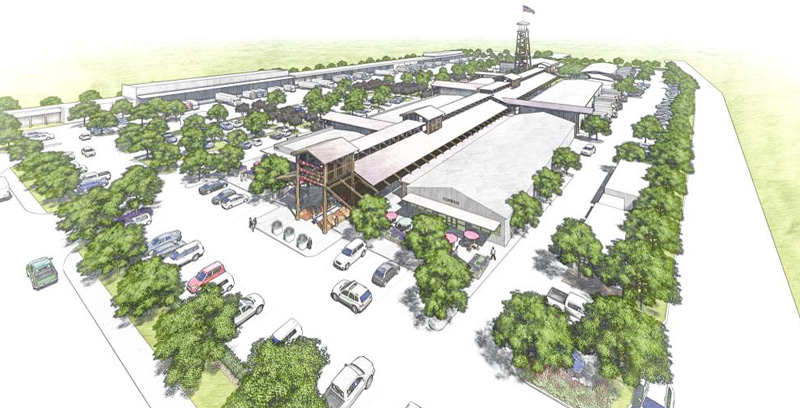
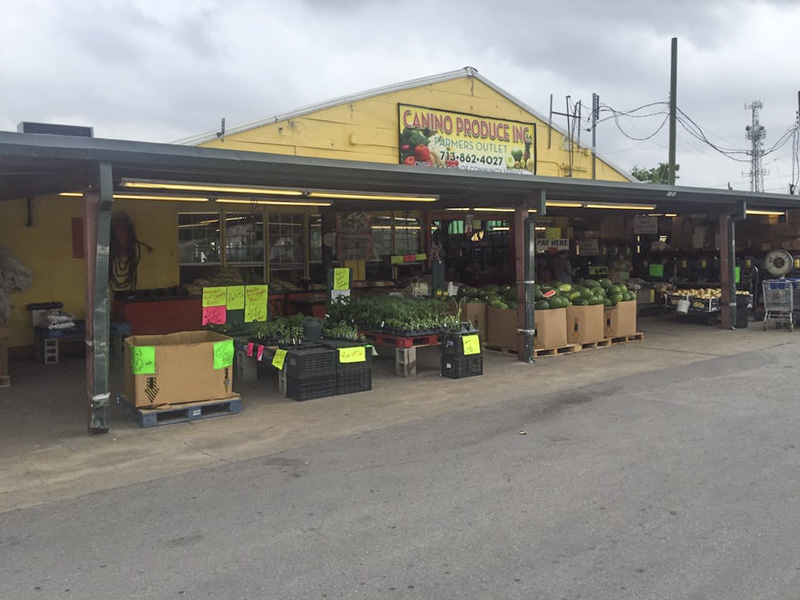 As mentioned earlier today, more details on the plan to redo the 1940’s farmers market on Airline Dr. are now out — MLB released some sketches and site plans this morning, which the company says are meant to help turn the spot into a “destination retail experience.” The renderings show most of the gaps between the existing market buildings bridged by new rooftops and green spaces, connecting the structures into a single complex (some of which will likely get air conditioned for fish and dairy operations and the like).
As mentioned earlier today, more details on the plan to redo the 1940’s farmers market on Airline Dr. are now out — MLB released some sketches and site plans this morning, which the company says are meant to help turn the spot into a “destination retail experience.” The renderings show most of the gaps between the existing market buildings bridged by new rooftops and green spaces, connecting the structures into a single complex (some of which will likely get air conditioned for fish and dairy operations and the like).
It’s not totally clear whether some the existing buildings are actually going to be painted white, or if the details of planned finishes just haven’t made their way into the renderings at this stage of design — but the currently-yellow front of Canino’s can be spied rocking a pale grey skin in the sketches above and below, behind the market’s new double-height entry facade:
CANINO MARKET HAD ALREADY KINDA GENTRIFIED, SAY FOLKS PLANNING UPCOMING $10-MILLION REDO 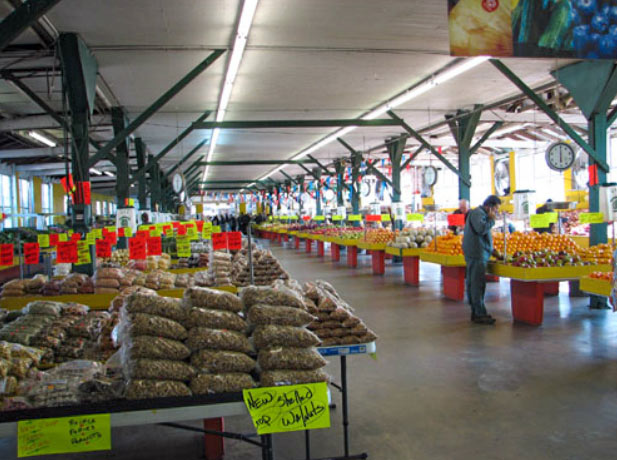 “Over time,” writes Nancy Sarnoff for the Chronicle this morning after talking to some of the folks behind that in-the-works redevelopment of the recently sold Canino farmer’s market on Airline Dr., the market has already become “a place where produce [is] shipped and trucked in from places like Mexico and elsewhere, like it is to a grocery store.” The local farmers and early-morning bread-seekers are mostly gone, and property values  in the neighborhood are already on the rise — as are the townhomes. “We’ve come to the realization that no matter what we do here, it’s already happening,” MLB Partners’s Todd Mason tells Sarnoff; “We’ve looked around to buy more over here, and prices have already escalated.” The developers also run through some of the details for the $10-million project with Chris Baldwin over at PaperCity, who writes that “the 17.5-acre site is being almost completely re-imagined” — potential changes include some 60,000 sq. ft. of additional space, a “large lounging lawn,” a children’s play area, and “a distinctive towering sign from Studio Red Architects that can be seen from the freeway.” [Houston Chronicle and PaperCity; previously on Swamplot] Photo: Canino Produce Market
“Over time,” writes Nancy Sarnoff for the Chronicle this morning after talking to some of the folks behind that in-the-works redevelopment of the recently sold Canino farmer’s market on Airline Dr., the market has already become “a place where produce [is] shipped and trucked in from places like Mexico and elsewhere, like it is to a grocery store.” The local farmers and early-morning bread-seekers are mostly gone, and property values  in the neighborhood are already on the rise — as are the townhomes. “We’ve come to the realization that no matter what we do here, it’s already happening,” MLB Partners’s Todd Mason tells Sarnoff; “We’ve looked around to buy more over here, and prices have already escalated.” The developers also run through some of the details for the $10-million project with Chris Baldwin over at PaperCity, who writes that “the 17.5-acre site is being almost completely re-imagined” — potential changes include some 60,000 sq. ft. of additional space, a “large lounging lawn,” a children’s play area, and “a distinctive towering sign from Studio Red Architects that can be seen from the freeway.” [Houston Chronicle and PaperCity; previously on Swamplot] Photo: Canino Produce Market
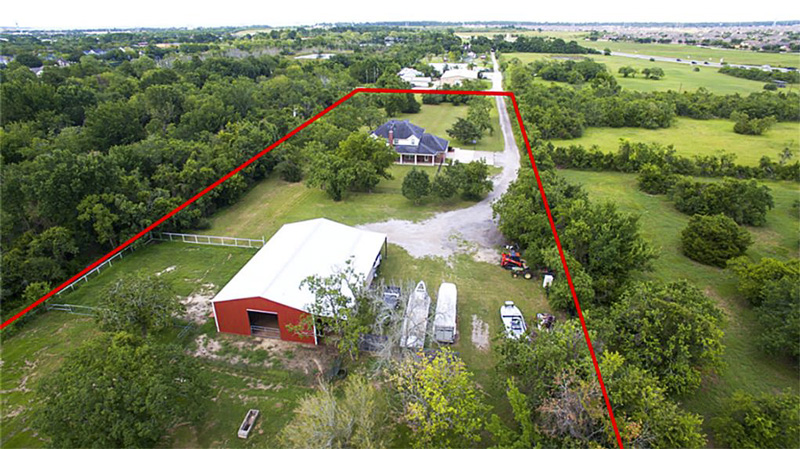
- 2730 Lawrence Rd. [HAR]
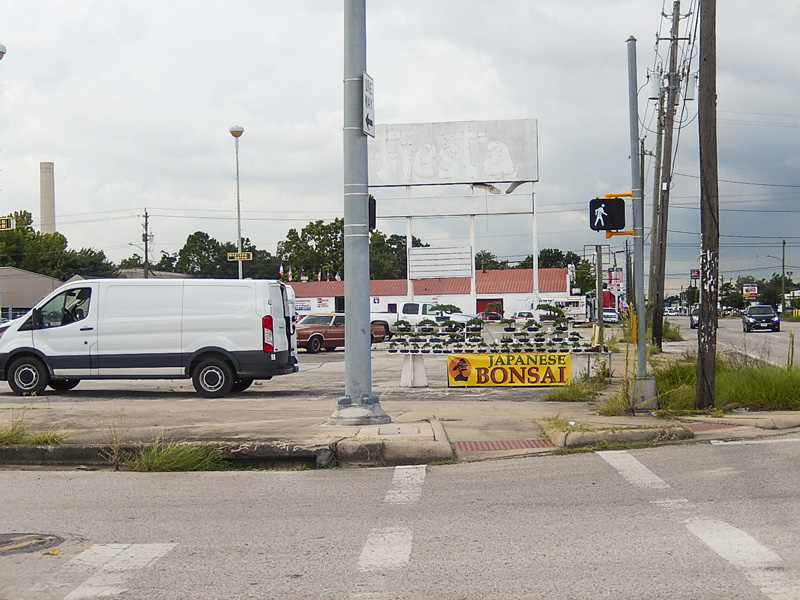
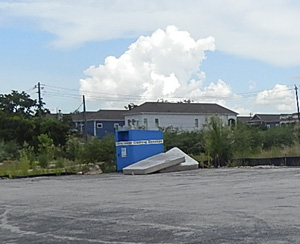 The revised word from H-E-B on a construction start date for the 2-story store planned at N. Shepherd Dr. and 23rd St. was August 25th, as of late last month. Until then, some of that empty space is being put to use by a small bonsai tree sales operation, a reader in the neighborhood reports. And in case anyone else in the area is looking for a place to crash briefly, a small pile of mattresses has appeared near the dumpster at the back end of the lot.
The revised word from H-E-B on a construction start date for the 2-story store planned at N. Shepherd Dr. and 23rd St. was August 25th, as of late last month. Until then, some of that empty space is being put to use by a small bonsai tree sales operation, a reader in the neighborhood reports. And in case anyone else in the area is looking for a place to crash briefly, a small pile of mattresses has appeared near the dumpster at the back end of the lot.
The footprint of the departed Fiesta building, meanwhile, appears to have let itself go during the long period of unemployment. As of yesterday the previously cleared spot was sporting a shaggy new look, accessorized with at least one snappy yellow tag noting the city’s disapproval of the new growth:Â
COMMENT OF THE DAY: WHERE THE TEXAS OFFICE SPACE BUBBLES TEND TO BLOW  “Houston is somewhat more diversified in terms of total jobs than it used to be – that’s why the region never went negative on job growth during this downturn. . . . That said, as far as users of large-scale office space go, there’s no question that diversification is sorely lacking. The energy industry and its service providers are still extremely dominant and drive the major swings in the market. This is a huge contrast to the Dallas side of the North Texas region . . . Look at the major relocations to the north suburban market there: huge deals — none of them are energy companies. . . . Around here, when an oil and gas boom is on, it seems to suck up all the oxygen, and growth in other sectors is squeezed out. When the inevitable downturn happens, there’s no rush by other economic sectors to fill the vacuum, despite the availability of high quality space and housing (and labor). I believe the Austin office market’s level of dependency on its tech sector is akin to Houston’s energy sector dependence, so a tech bust would be a disaster for them.” [Local Planner, commenting on Hines Parting Ways with 21 Eleven; The Most Expensive ZIP Code for Renters in Houston] Illustration: Lulu
“Houston is somewhat more diversified in terms of total jobs than it used to be – that’s why the region never went negative on job growth during this downturn. . . . That said, as far as users of large-scale office space go, there’s no question that diversification is sorely lacking. The energy industry and its service providers are still extremely dominant and drive the major swings in the market. This is a huge contrast to the Dallas side of the North Texas region . . . Look at the major relocations to the north suburban market there: huge deals — none of them are energy companies. . . . Around here, when an oil and gas boom is on, it seems to suck up all the oxygen, and growth in other sectors is squeezed out. When the inevitable downturn happens, there’s no rush by other economic sectors to fill the vacuum, despite the availability of high quality space and housing (and labor). I believe the Austin office market’s level of dependency on its tech sector is akin to Houston’s energy sector dependence, so a tech bust would be a disaster for them.” [Local Planner, commenting on Hines Parting Ways with 21 Eleven; The Most Expensive ZIP Code for Renters in Houston] Illustration: Lulu
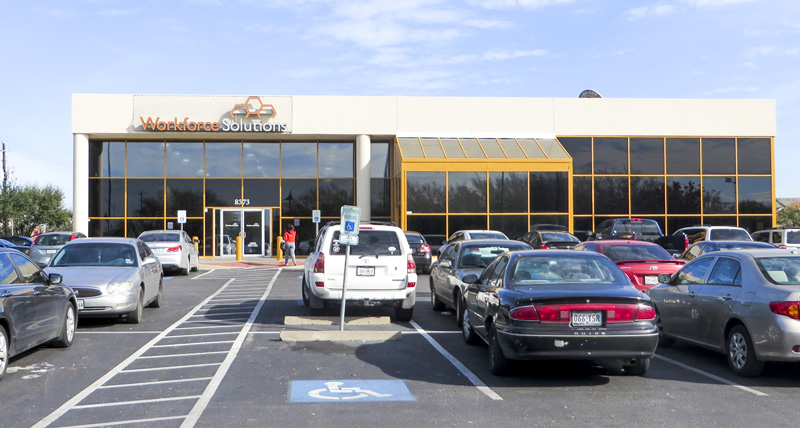
Heads up, California-ization vigilantes: A diligent transaction sifter over at HAIF noted last night that In-N-Out Burgers recently bought 8373 Westheimer Rd. (currently home to a branch of public employment center Workforce Solutions in the parking lot of the nearby Walmart Supercenter on Dunvale Rd.). The 1997 standalone building is right around the corner from the AMC Studio 30, and sits in something of a Whataburger gap — not one of the 5 nearest Whataburger locations is closer than 1.7 miles by car. The space had been put on the market a few times in the last few years with no takers; the sale to In-N-Out went through in late May, per county records.
Noises have been made before about In-N-Out possibly moving to (or near) Houston, but CBRE VP Jazz Hamilton told the Chronicle’s Katherine Feser only this past February that he expected the chain’s first location to open by the end of the year — adding that Houston will “see [more locations] come in quietly . . . All of a sudden, they’ll start building all at once.”
- In-N-Out Burger Coming to Houston [Houston Chronicle]
- 8373 Westheimer Road [LoopNet]
- Previously on Swamplot:Â The Rumors In-N-Out of Sugar Land;Â In-N-Out Burger Eager To Start Packing for Houston
Photo of 8737 Westheimer Rd.: LoopNet

- 3363 Inwood Dr. [HAR]

